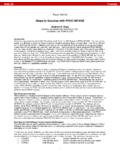Transcription of Propensity Score Methods Using SAS - BASUG - The Boston ...
1 Propensity Score Methods Using Propensity Score Methods Using SASSAS R. Scott Leslie, MPHR. Scott Leslie, MPHMedImpact Healthcare Systems, Healthcare Systems, Diego, CASan Diego, ResearchObservational ResearchKey strength: estimate effect of exposures or Key strength: estimate effect of exposures or treatment in treatment in real worldreal world conditionsconditionsAdvantagesAdvantages Data readily available, inexpensiveData readily available, inexpensive Generate quick resultsGenerate quick results Results more generalizable than controlled trialsResults more generalizable than controlled trials Offer solution to limitations of RCTO ffer solution to limitations of RCTE thicsEthicsFeasibilityFeasibility--Costs /resourcesCosts/resourcesTimeTime--resul ts lagresults lagHawthorne effectHawthorne effectExternal validityExternal validity--patient mixpatient mixSmall samplesSmall samplesObservational ResearchObservational ResearchKey limitation: comparison groups not randomizedKey limitation.
2 Comparison groups not randomizedConsequence: biased estimate of treatmentConsequence: biased estimate of treatmentDisadvantagesDisadvantages Lack of randomizationLack of randomization Differential selectionDifferential selection--leads to differences in observed leads to differences in observed and unobserved characteristicsand unobserved characteristics Heterogeneity of populationsHeterogeneity of populations Varying statistical analysesVarying statistical analysesBias in Observational StudiesBias in Observational StudiesIs outcome due to treatment? Or other factors?Is outcome due to treatment?
3 Or other factors?Limited by biasLimited by bias Selection biasSelection bias ConfoundingConfounding Reverse causalityReverse causalitySelection bias General definition by Rothman- a distortion resulting from the manner in which subjects are selected into the study population Specified by Faries- differential probability of an individual assigned to a treatment condition and the characteristics of that individual are confounded with treatment outcomes Overt (observed) and hidden (unobserved)Rothman KJ, Greenland S. Modern Epidemiology, 3rdEdition. Lippincott Williams & Wilkins.
4 Et al, Analysis of Observational Health Care Data Using SAS, SAS Institute. ADrug BGuidance on Observational ResearchGuidance on Observational ResearchGood practices for observational studies The International Society of Pharmacoepidemiology (ISPE) International Society for Pharmacoeconomics and Outcomes Research (ISPOR) Methods for CER reviews The Effective Health Care Program working document. Effective Healthcare Methods Guide for CER Reviews Guide on evaluating quality CER -The GRACE Initiative(Good Research for Comparative Effectiveness)Guidelines on reporting observational CER studies The STROBE(Strengthening the Reporting of Observational Studies) GuidelinesGuidelines when working with patient registries AHRQ, Registries for Evaluating Patient Outcomes.
5 A User's GuideGuidelines on Systematic Reviews-CochraneHandbook for Systematic Reviews of InterventionsDreyer, Epidemiology, 2011 Sturmer, Epidemiology,2011 Methods to Estimate EffectsMethods to Estimate EffectsDesign stageDesign stage Match subjectsMatch subjects Exclusion and inclusion criteria Exclusion and inclusion criteria Analysis stageAnalysis stage--Use statistical techniques Use statistical techniques Regression, ANCOVA, Propensity scoringRegression, ANCOVA, Propensity scoringGoal = Goal = balance groups balance groups ononcharacteristicscharacteristics mimic randomization or simulate random treatment mimic randomization or simulate random treatment assignment , assignment , quasi randomizationquasi randomization more confident stating outcome is due to treatment more confident stating outcome is due to treatment vs.
6 Explained by other factorsvs. explained by other factorsD Agostino Sr., Medical Care, 1995 Propensity Score Methods as a Propensity Score Methods as a Potential FixPotential FixTraditional techniques ( , regression adjustment) may be limited if Using too few covariates in adjustment processPropensity Score techniques avoids limitation Summarizes covariate information into a single scoreEditorial by DEditorial by D Agostino (Jr. and Sr.) in JAMAA gostino (Jr. and Sr.) in JAMA Use 2 Methods to adjust for group differencesUse 2 Methods to adjust for group differencesPropensity scoringPropensity scoring--balance groupsbalance groupsAnalysis of covarianceAnalysis of covariance--add precisionadd precisionDD Agostino RB Jr & Sr, JAMA, 2007 Agostino RB Jr & Sr, JAMA, 2007 What is the Propensity Score ?
7 The Propensity Score is the conditional probability of The Propensity Score is the conditional probability of being treated based on individual covariatesbeing treated based on individual covariates Rosenbaum and Rubin demonstrated p scores can account for Rosenbaum and Rubin demonstrated p scores can account for imbalances in treatment groups and reduce bias by resembling imbalances in treatment groups and reduce bias by resembling randomization of subjects into treatment groupsrandomization of subjects into treatment groupsPropensity Score techniques used to compare groups Propensity Score techniques used to compare groups while adjusting for group differenceswhile adjusting for group differences Regression adjustmentRegression adjustment MatchingMatching Stratification (subclassification)Stratification (subclassification)Rosenbaum and Rubin 1983.
8 Rosenbaum and Rubin 1983. The Central Role of the Propensity Score in The Central Role of the Propensity Score in Observational Studies for Causal EffectsObservational Studies for Causal Effects , , BiometrikaBiometrika, 70, 41, 70, Propensity Scores Using Creating Propensity Scores Using PROC LOGISTICPROC LOGISTICL ogistic regression: Used to predict probability of event occurLogistic regression: Used to predict probability of event occurring ring as a function of independent variables (continuous and/or as a function of independent variables (continuous and/or dichotomous)dichotomous)Logistic model:Logistic model.
9 Propensity scores created Using PROC LOGISTIC or PROC Propensity scores created Using PROC LOGISTIC or PROC GENMODGENMOD The Propensity Score is the conditional probability of each The Propensity Score is the conditional probability of each patient receiving a particular treatment based on prepatient receiving a particular treatment based on pre--treatment treatment variablesvariables Creates data set with predicted probabilities as a variableCreates data set with predicted probabilities as a variable Or use logit of p Score log (1/1Or use logit of p Score log (1/1--p)p))(11)(iXieYP + +=Creating Propensity Scores: CodeCreating Propensity Scores: Codeproc logistic data = indsn;proc logistic data = indsn;class naive0;class naive0;model tx (event=model tx (event= Drug ADrug A ) = age female b_hmo ) = age female b_hmo pre_drug_cnt_subset naive0 pre_refill_pct pre_drug_cnt_subset naive0 pre_refill_pct copay_idxdrug pre_sulf pre_htn pre_asthma copay_idxdrug pre_sulf pre_htn pre_asthma pre_pain pre_lipo pre_depresspre_pain pre_lipo pre_depress/link=logit rsquare;/link=logit rsquare.
10 Output out = psdataset pred = ps output out = psdataset pred = ps xbeta=logit_ps;xbeta=logit_ps;run;run;PS = predicted event probability of receiving treatment based on specified factorsEstimating P ScoresPropensity Score is the conditional probability of Propensity Score is the conditional probability of each patient receiving a particular treatment each patient receiving a particular treatment based on prebased on pre--treatment variablestreatment variables More covariates better than less (Austin, 2007)More covariates better than less (Austin, 2007) Include characteristics that are unbalanced b/w Include characteristics that are unbalanced b/w treatment groupstreatment groups Success: Did it balance treatment groups?







